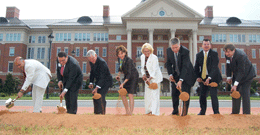Last Friday, I visited Kannapolis, North Carolina to attend a groundbreaking ceremony for the second phase of an infrastructure project that will deploy or improve broadband networks throughout much of the state, particularly in rural areas. The effort is led by MCNC, a nonprofit broadband provider that has operated the North Carolina Research and Education Network (NCREN) for more than 25 years. The project—funded by a $104 million Recovery Act investment and $40 million in private sector matching funds—will deploy approximately 1,650 miles of new fiber. Combined with upgraded facilities, the project will add 2,600 miles of new or improved infrastructure to MCNC’s network, extending broadband to nearly 1,200 community anchor institutions, including universities, schools, community colleges, libraries, healthcare providers, and public safety facilities. Nearly 500 of those anchor institutions have already benefitted from improved access to the broadband network. Joe Freddoso, the president and CEO of MCNC, said they applied for the Recovery Act funding because bandwidth use by North Carolina institutions was growing by 30 to 40 percent each year—and without network improvements, rural communities would not be able to meet their future bandwidth needs.

State and local elected officials celebrate the groundbreaking (photo credit MCNC)
In fact, before we funded MCNC, its network delivered speeds of 1 Gbps or faster to only 12 out of 100 counties in North Carolina. MCNC will expand that number to 83 counties—a nearly 600 percent increase in statewide broadband capabilities. This will not only improve education and other public services, but it can also spur additional private sector investment. For example, as with other Recovery-Act-funded broadband networks, local Internet providers will be able to utilize the new infrastructure to extend broadband service to homes and businesses that may otherwise be too costly to reach.
Even while construction is underway, the project is bringing economic opportunities. MCNC reports that the Recovery Act project has already created or retained about 400 jobs. In addition, local businesses are serving as vendors, like Hickory-based CommScope, which is supplying fiber and other network materials.
Perhaps the most exciting aspect of the project is how a modern communications infrastructure can support economic revitalization. For example, Kannapolis was a textile mill town until 2003, when the mill closed and displaced thousands of workers. Now, less than a decade later, Kannapolis is an emerging biotechnology and life sciences hub, home of the new North Carolina Research Campus. But the campus needs more bandwidth. In some cases, researchers have stored data on portable media and driven across the state to deliver the data to other institutions. The MCNC project will bring much-needed broadband capacity to the campus, a vital ingredient in the transformation of this 20th century American mill town to a 21st century global research center.
There are many more North Carolina communities, often in rural areas of the state, that could rebuild their economies once they get broadband access. These are cities and towns with small businesses and hard-working people who are eager for the new opportunities that high-speed Internet makes possible. Friday’s groundbreaking marked another important step towards making that happen.

